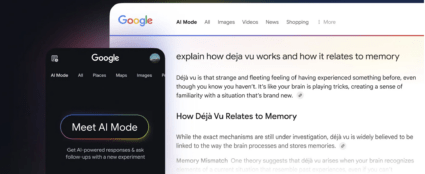Statistically, it’s more likely that you’re reading this page from a mobile device than you are from a laptop or desktop computer. If you are, you’re seeing the mobile version—and believe it or not, according to Google, that’s the “real” version.
That’s because, for many years now, Google has used the mobile version of a site as the primary basis for indexing and ranking. That’s called “mobile-first indexing,” and considering how prevalent mobile traffic is today, it makes sense.
The question is, though: How can marketers make mobile-first indexing work for their brands, and what does it mean for SEO in the age of AI search?
A brief history of mobile-first indexing
Remember when a lot of websites weren’t optimized for mobile? (Just kidding; that’s somehow still true today.) Jokes aside, mobile-first indexing hasn’t always been a thing, so let’s take a quick look at its history.
From desktop to mobile: a timeline
Google originally indexed sites based on the content of their desktop versions. That was logical in the mid-2000s and early 2010s, since hardly anyone surfed the web on anything other than a desktop or laptop computer.
In 2016, when mobile devices had begun gobbling up an increasing share of web traffic, Google announced that it would roll out mobile-first indexing over a period of years. It became the default for new websites in 2019, and by 2023, the rollout was complete.
Why Google made the shift
Google changed to mobile-first indexing for a simple and understandable reason: Most people had begun to browse the internet on their phones at least some of the time.
At the end of 2016, around 45% of web traffic came from mobile devices, meaning that a huge chunk of Google users were searching via mobile. To give those users a good browsing experience, it was critical that Google prefer sites designed to be fast and responsive on mobile devices.
Ultimately, Google’s decision came down to the changing intent of users. They wanted search engine results pages (SERPs) to accurately reflect both what users were searching for and how they were searching for it—and that meant prioritizing mobile sites in search results.
How mobile-first indexing works
Mobile-first indexing works pretty much the same as Google’s standard indexing procedure. That is: a piece of software called a crawler (also known as a Googlebot) automatically scans the entire public web for pages, then categorizes and rates the quality of the pages’ content. Google then integrates the results of this process into the search results that it serves to users (other search engines like Bing and DuckDuckGo work similarly).
The main difference is that Google uses a separate, specially-designed crawler to index mobile content. This crawler sends access requests that mimic those of an iOS or Android device, so web servers see it as a mobile device and serve up the mobile-optimized page.
Understanding mobile-first vs. mobile-friendly
The terms “mobile-first” and “mobile-friendly” sometimes get used interchangeably, but they mean different things. Here’s the difference:
- Mobile-first is used specifically to talk about how Google crawls and ranks content.
- Mobile-friendly is a more general term used to talk about web pages developed to provide a smooth page experience for mobile users.
A properly implemented mobile-friendly site looks just as good on mobile as it does on desktop. That’s a boon for your content in mobile-first indexing, since the mobile site is the basis for how Google interprets the relevance of your page.
What Googlebot looks for
Googlebots generally will index:
- Mobile versions of websites, whether they’re created using a responsive design framework or a separate mobile site
- Desktop versions of websites that are still accessible on mobile
- JavaScript-rendered content and web apps, so long as they work on mobile devices
On the other hand, the bots generally won’t index:
- Pages that don’t load on mobile for any reason, including pages that are blocked from mobile access or will not render because of errors
- Misconfigured content that doesn’t load correctly on mobile
- Pages that require plug-ins that don’t work on mobile browsers
Basically, if the bots can see it when the mobile version loads, it’s generally eligible for indexing by Googlebots. That said, this is just the baseline you need to satisfy to get your site indexed. Achieving good rankings on SERPs takes a coordinated effort to follow the best practices of mobile optimization.
Aligning your SEO strategy with mobile-first indexing
Brands need a strategy that accounts for how both users and search engines experience content on mobile devices. Getting familiar with Google’s mobile-first indexing tips is a great place to start—but if you need the really short version, these are the absolute must-know elements:
Use responsive design with content parity
Responsive design is an approach to web development that enables browsers to quickly and easily load content on different device types. Basically, responsive design uses a collection of CSS and HTML tools to create websites that display equally well on a desktop, phone, or tablet. It’s simple, efficient, and it’s the approach that Google officially recommends for mobile web development.
Content parity is a key part of responsive design. That means that all the content you have on your desktop site should be optimized using responsive principles for mobile as well—because, again, if it’s not on your mobile site, Google and most other search engines won’t index it.

Source: Computer Plus Limited
Prioritize speed and user experience
Mobile-first SEO also includes how fast and intuitive your mobile site is to navigate. If your site loads slowly, has lots of tiny buttons, or features other mobile-unfriendly design elements, you might see reduced engagement and visibility on smaller screens.
That means that it’s more important than ever to follow the standard best practices of page speed and UX, which include:
- Understand and monitor your Core Web Vitals
- Compress images and consider using mobile-friendly image formats like WebP
- Keep paragraphs and sentences short whenever possible, and use bulleted lists to make text more readable
- Make sure buttons and links are large enough that mobile users can easily click them
- Think carefully before you use pop-ups and interstitials, which can hurt your users’ mobile experience
Maintain SEO fundamentals across devices
Your mobile pages also need to maintain all the key SEO elements of a desktop page, such as:
- Clearly structured H1, H2, and H3 headings
- Bot-crawlable links
- Alt text for images
- Schema markup
Remember, the mobile version of your site is what Google is using to evaluate your content’s relevance to user queries, so make sure anything you want indexed is present on both your desktop and mobile sites.
How AI is informing the mobile-first SEO landscape
The first SERP position is no longer the singular Holy Grail of SEO. Everyone’s desperate to know how brands can capture real estate in new AI-based features like Google AI Mode. As it turns out, mobile-optimized content is incredibly important here, too.

Source: Google
AI-powered search highlights mobile content
If there’s one thing we know about how to please the machine learning models that power AI search, it’s that structured content is a must. Search models rely heavily on structured, mobile-friendly content when surfacing answers in AI Overviews and other AI-based features. Get the structure right, and you have a better chance of scoring a valuable click-through link in an AI Overview.
The best practices here are pretty simple. Choose clean layouts that load quickly, make sure your page is organized with headings, and use bulleted lists and/or short paragraphs to improve readability. These also help ensure that human users can find your answers easily when they click through from an AI Overview link.
Hidden content is indexable, but UX still matters
“Hidden content” refers to webpage content that’s publicly accessible, but hidden behind features like tabs, accordions, or expandable elements. It’s common to hide content to improve page speed and/or UX, especially for mobile users.
The good news about hidden content is that Googlebots can and do index it. So long as the content is present in the HTML of your mobile site, it’s eligible to be indexed by crawlers.
Here’s the catch: Hidden content can be hard to engage with. Users may have trouble finding it once they’re on your site, and the UX experience may be not-so-great if it involves clicking small buttons or other actions that are hard to do on a mobile device. That can ultimately affect the visibility of your content both in SERPs and AI-driven experiences, so above all, don’t slack on UX-testing your content, especially when you’re using hidden elements.
The future of mobile-first indexing
To succeed in organic search, your content has to perform and render well on mobile devices—period. Without mobile-friendly development, you’re hurting not just your user experience, but also your brand’s ability to show up in AI overviews and SERPs.
It’s true that mobile-first best practices are well-documented and easy to find online, but it’s much easier to read about them than to actually implement them. Optimizing for mobile often requires long-term collaboration between SEO, UX, and dev teams, not to mention the need for strong content to begin with.
Fortunately, we’re good at all this stuff. Wpromote is a tech-forward content marketing agency that’s been doing mobile-optimized content since before anybody knew that mobile-optimized content would be a thing. Today, we’re cracking open the biggest challenges of SEO in the 2020s, including developing a comprehensive AI search strategy—all of which starts with an assessment of the gaps in your mobile SEO strategy.







Responses